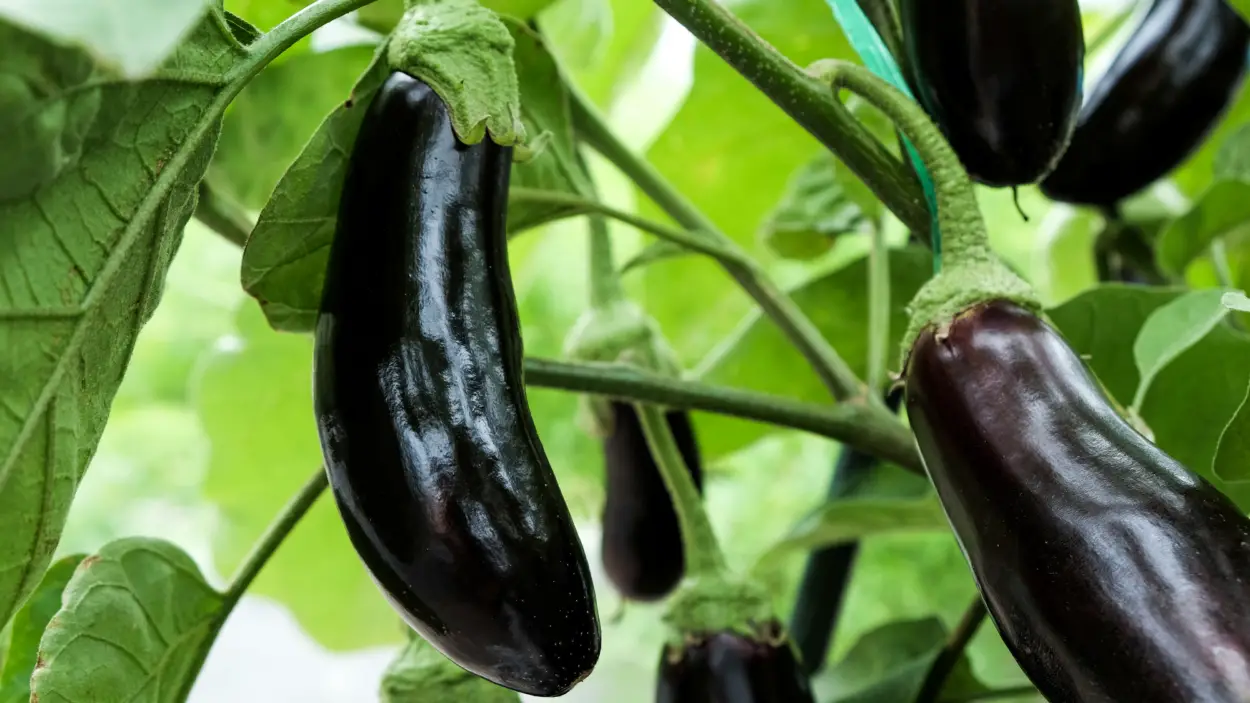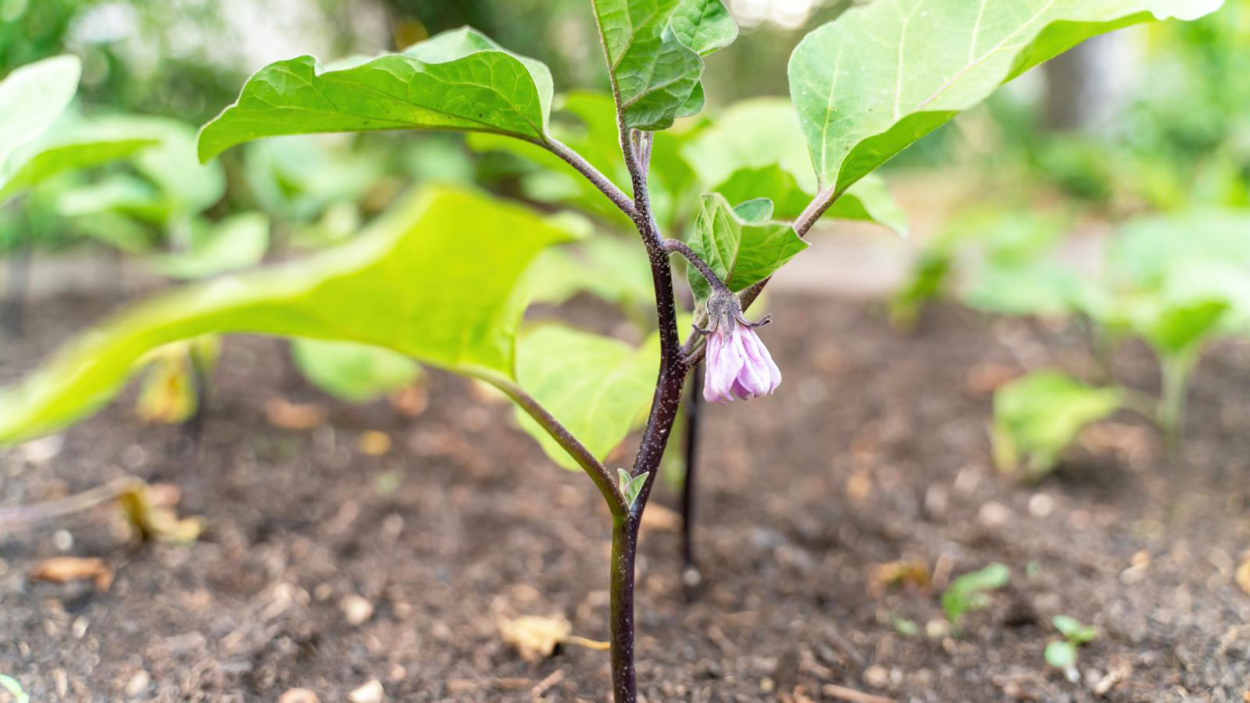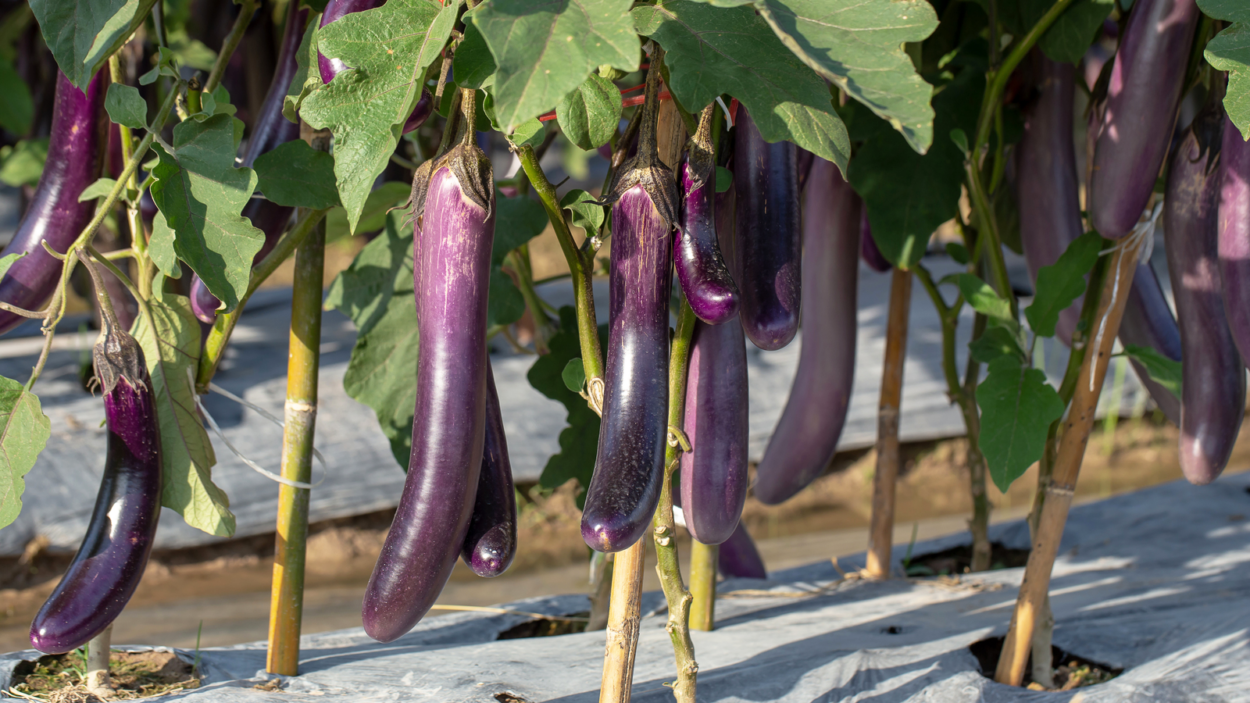The Secret To Growing Hydroponic Eggplant: A Complete Guide

This post follows our research editorial guidelines.

Hydroponics isn’t just a new trend; it’s a revolutionary way to grow plants indoors that could change the way you garden for good. If the idea of growing big, tasty eggplants in your own home sounds interesting to you, then you’ve come to the right place.
You’re probably thinking, “Eggplants? Indoors? Really?” Yes, without a doubt!

Hydroponically growing eggplant needs a controlled setting, like a greenhouse or an indoor grow room, to provide the best growing conditions. These technologies facilitate the growth of eggplants through the use of seeds. Eggplants are from the same botanical family as peppers and tomatoes (Nightshades) which are extremely well adapted to the constant moisture of hydroponics.
Let’s dive in to know more!
Can You Grow Hydroponic Eggplant?
Yes, you can! Growing eggplants in a hydroponic system is not only possible but also yields superior results under the right conditions. Hydroponic systems make it easier for plants to grow by giving them direct access to the water and nutrients they need. Having this direct and constant access to nutrients speeds up the development of the eggplant bush resulting in faster fruiting. Ensure the water conditions are at the right pH for these conditions to be met.
Growing eggplants this way doesn’t take a lot of space either. “You can have a hydroponic system that’s stacked onto your balcony, fence or balustrades,” says Martin Pfeffer, a horticulturist at Canna.
The cultivation of eggplants in a hydroponic setting offers a fun and efficient way to engage with the gardening process. Want to know my favorite part? The extensive range of eggplant varieties you get to choose from, each bringing its unique aesthetic and flavor profile to your garden.
From petite green or white spheres to elongated pink or purple Japanese varieties, you’re spoilt for choice.
A word of caution, though: eggplant germination is picky and needs temperatures between 70 and 90 degrees Fahrenheit. In addition, germination rates aren’t always one hundred percent, so sowing extra seeds is always a good idea.
Furthermore, eggplants demand a careful balance of nitrogen, phosphorus, potassium, and other trace elements for their growth, which can easily be managed with readily available hydroponic nutrient formulas. It’s a rewarding journey full of learning opportunities and delicious outcomes.
How Long Does It Take To Grow Eggplant Hydroponically?

Growing eggplants hydroponically means we’re ditching the soil and delivering nutrients straight to our plant’s roots through water. It’s like an all-you-can-eat buffet for your eggplant, but remember, it’s not just about feeding them well, it’s about creating an environment where they feel at home. So, think about your setup like a mini greenhouse or indoor grow room.
But how long does it take to grow hydroponic eggplants? From seed to harvest, you’re typically looking at around 12 to 14 weeks. Yes, it’s a bit of a wait, but trust me, the end result is worth it!
Best Eggplant Varieties For Hydroponics
Given below are some of the most popular and hydroponics-friendly eggplants.
Type 1: Black Beauty
The Black Beauty eggplant is a favorite of both seasoned and amateur gardeners alike. Typically spanning between 4 and 6 inches in length, this classic varietal is prized for its big, glossy, dark purple fruits. The fruits have a mellow, somewhat sweet flavor and a thick, creamy texture that resembles that of avocados.
When it comes to growing Black Beauty hydroponically, it’s an ideal choice due to its relatively quick growth and high yield. The plant thrives in a temperature range of 70°F to 85°F, making it suitable for year-round indoor growing. The optimal pH level for Black Beauty is slightly acidic, between 5.8 and 6.3.
Providing ample light is essential for this plant’s growth, requiring around 14 hours of high-intensity light each day. I recommend using high-quality LED grow lights to ensure the plant receives enough light for photosynthesis. LEDs are not only cost-effective but also produce less heat through their energy efficiency.
From the time of seeding, Black Beauty typically takes around 70 to 80 days to reach maturity and start fruiting. It’s also known for its bell-shaped, vibrant purple flowers that bloom before the fruiting stage.
Type 2: Ichiban

The Ichiban eggplant, also known as the Japanese eggplant, is a sought-after variety because of its remarkably long and slender shape.
Each mature plant takes up about 3 feet of space for its canopy to expand and grow approximately 4 feet tall if not topped. Like its ‘Black Beauty’ cousin, Ichiban prefers a slightly acidic environment with a pH between 5.5 and 6.2.
It does well in a daytime temperature range of 70 to 90 degrees Fahrenheit. However, extreme heat (over 90 degrees Fahrenheit) can cause the plant to stress and shed its flowers, drastically reducing the harvest.
Once seeded, you can expect to see glossy, slender fruit in approximately 50 to 60 days.
Type 3: Nadia
The Nadia eggplant is an Italian variety characterized by its large, glossy, dark-purple fruits, typically measuring up to 7 inches in length. Its thick, succulent flesh is mildly sweet, making it a superb choice for various cuisines, including baking, grilling, or stuffing.
You can expect to see ripe fruit within 60-70 days of planting the seedlings. Nadia plants enjoy a warmer climate, so aim for temperatures around 75°F to 85°F, with a pH level between 5.8 and 6.3. Nadias needs high-intensity lighting for 14 to 16 hours a day for optimal growth.
Type 4: Rosa Bianca
Growing up to 4-6 inches in diameter, the Rosa Bianca eggplant has a rounded, slightly irregular shape. The plant is a hearty grower and thrives in warm, sunny conditions, making it an excellent choice for home gardeners in warmer climates.
This variety also displays resistance to a range of common eggplant diseases, making it easier to maintain for both novice and experienced gardeners.
In the kitchen, Rosa Bianca is like a little flavor sponge, soaking up all the good stuff in your recipes. Grill it, bake it, sauté it, whatever you like! It’s a champ in classic dishes like ratatouille and eggplant parmigiana, but don’t be afraid to get creative.
How to Grow Hydroponic Eggplant
Growing hydroponic eggplant might seem like a bit of work initially, but the delicious results make it all worthwhile. Plus, it’s a more sustainable way to garden, using no soil and significantly less water than traditional methods. Here’s an easy guide:
Step 1: Seed Germination
Start by germinating eggplant seeds, preferably in a controlled environment. The optimal temperature is between 70°-90°F, so consider using a heat mat to maintain consistent warmth. I place my seedling trays on a shelf above my grow lights so they re able to take in the output of heat.
Be patient, as the germination rate isn’t always 100% and it may take about 7 to 10 days for the seedlings to emerge. After two weeks, begin feeding the seedlings with a soluble fertilizer once a week.
Step 2: Choose Your Hydroponic System
When it comes to growing hydroponic eggplants, there are multiple systems to choose from, such as ebb and flow, NFT, or deep water culture. If you opt for deep water culture, make sure to oxygenate the water well to avoid salt accumulation, which could stress the plants.
Step 3: Nutrient Management
Eggplants need a blend of macronutrients like nitrogen, phosphorus, and potassium, as well as some trace elements like calcium and magnesium. You can find ready-mixed hydroponic nutrient formulas that work perfectly for eggplants.
Start with a balanced grow formulation, then switch to a fruiting formulation with higher potassium levels once the first fruits appear.
Step 4: Lighting and Temperature Control
Eggplants need at least eight hours of light per day. If you can’t provide natural sunlight, consider using grow lights. They also love warm temperatures, ideally between 70-80°F, but never below 65°F.
Step 5: Pollination, Harvesting, and Handling

Eggplants are self-fertile, but indoor hydroponic systems lack natural pollinators, so lend a hand by gently shaking the plant or brushing pollen between flowers with a small paintbrush.
When it comes to harvesting, look for glossy, thin-skinned fruits. Check the inner flesh; it should be creamy in color and the seeds small and not visible. Handle your eggplants gently as they can bruise easily. Cut them off with a sharp knife or pruners, leaving a short piece of stem attached.
Light
Eggplants are sun-loving plants that require plenty of light for healthy growth. If growing indoors, use high-intensity discharge lamps or full-spectrum LED lights. Aim for a light exposure of 14-16 hours per day with an 8 hour period of darkness to allow your plants to rest.
Growing Medium
In hydroponics, inert growing mediums like coco coir, perlite, or Rockwool work well. These materials allow good aeration and efficient nutrient uptake. Remember, eggplants have extensive root systems, so pick a medium that provides enough room for root expansion.
Water pH and EC

Maintaining the right pH and Electrical Conductivity (EC) is crucial for nutrient absorption. The optimal pH level for growing eggplants hydroponically is between 5.5-6.0. Most city water will be slightly alkaline and well water which is typically “hard water” can be highly alkaline.
The biggest mistake you can make when growing hydroponically is not having the right water pH. I recommend starting off with a pH testing kit and a buffer liquid to adjust as needed. The PPM (parts per million) represents the amount of dissolved solids within the water and should be in the 1750-2450 range.
As for the EC level aim for somewhere between 2.5 and 3.5 mS/cm. Below this range you can add more nutrients to increase the EC, above this range, it’s time to change your water. Regularly monitor and adjust these levels to ensure your plants are healthy.
Nutrients
Eggplants require a good balance of macronutrients, especially nitrogen, phosphorus, and potassium. They also need trace elements like calcium and magnesium. Use a comprehensive hydroponic nutrient solution and consider switching to a bloom booster once the first fruits appear to boost yield.
Spacing
Give each eggplant sufficient space to grow. In hydroponics, place plants about 18-24 inches apart. This ensures that each plant gets enough light, nutrients, and air circulation, reducing the risk of disease spread.
Support
Eggplants can become heavy when they start bearing fruit. Use trellises, cages, or stakes to provide support and prevent branches from breaking. Secure the stems to the supports using soft ties, avoiding damage to the plants.
Pests

Common pests in hydroponic eggplants include aphids, spider mites, and whiteflies. Use safe pest management strategies like introducing beneficial insects or using organic insecticidal soaps. Regularly inspect your plants for signs of infestation.
Disease
Eggplants can be susceptible to diseases like verticillium wilt or root rot. Maintain a clean environment, use disease-free seeds, and ensure proper ventilation to minimize risk. If you notice diseased plants, remove them immediately to prevent the spread to other plants.
Types of Hydroponics to Grow Eggplant In
Among the various types of hydroponics, the most suitable for eggplant cultivation are the Nutrient Film Technique (NFT), Deep Water Culture (DWC), and Ebb and Flow.
NFT involves a constant flow of nutrient solution over the roots, providing a good oxygenation level. DWC, also known as the raft or lettuce-pond system, immerses the plant roots in a nutrient-rich water solution, fostering rapid growth.
Lastly, the Ebb and Flow system periodically floods the root zone with nutrient solution and then drains it back, offering good control over nutrient and oxygen supply.
FAQs
Is It Better to Grow Eggplant in Water or Soil?
Eggplants generally grow better in soil, as it provides the necessary nutrients and conditions for optimal growth. However, with the right setup and nutrient balance, eggplants can also be successfully grown in water through hydroponics.
Can I Grow Eggplant in my AeroGarden?
With AeroGarden, you have the option of getting pre-seeded pods. With the proper setup, nutrients, and attention to light and temperature needs, eggplants can be successfully cultivated in this hydroponic system. The AeroGarden nutrients that come with the kits are on the acidic side so less pH management is needed here, just some regular water changes.
Final Thoughts
Growing eggplants hydroponically can seem a bit out of the ordinary. We expect to see hydroponic tomatoes and even hydroponic peppers but for some reason, eggplants don’t seem to make the list for most. I hope now you can see that growing eggplants indoors couldn’t be easier. As you start on this journey, remember that patience and attention to detail will be your best allies.
Whether you’re a seasoned gardener or just getting started, let this guide be your first step toward growing succulent eggplants right at home. Imagine the joy of picking fresh eggplants from your very own indoor garden. So why wait? Let’s get growing!

Before you go!
Hydroponic Strawberries: the Best Berry To Grow at Home
What is the Best pH Hydroponics: How to Set And Maintain Levels
The Kratky method: A Passive Hydroponic way to grow plants
How to grow hydroponic herbs indoors: Beginners guide to growing fresh herbs at home